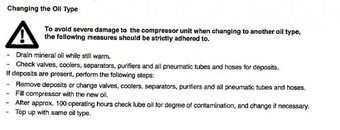swamp diver
Contributor
The filter change interval is dependent on the size of the filter (amount of desiccant), the output of the compressor, and most importantly the temperature of your compressor room. The first two are fixed numbers but the latter, temperature, varies considerably therefore your filter will not have a fixed service interval.
If you look at the Bauer filter air processing chart above a P0 filter is rated for 3200 cu. feet at 68 F separator inlet temperature which is the temperature of the air entering your triplex filter housing. If the compressor is properly installed and cooled this translates into a compressor room ambient temperature of 53 F. So unless your compressor room is cooled to 53 F you will never see 3200 cu. feet of processing capacity.
Your best case scenario assuming your compressor room is maintained at 53 F and your compressor has a free air output of 8 cfm (not scfm) would be:
(3200 cu. ft/8 cfm)/60 = 6.7 hours. If you're pumping at a higher temperature it all goes downhill from there because the amount of moisture carried into the desiccant rises exponentially with temperature.
Looking at the Bauer temperature correction factors below one can see that if your compressor room is 77 F your filter processing capacity will fall to 6.7 x 0.43 = ~ 3 hours. Warmer than that and capacity falls off further exponentially.
In other words as Jim suggests you will need to purchase a larger tower if you want to keep your compressed air dry and free of volatile organic compounds. Your P0 is undersized for the output of that compressor.
I agree that if you can afford it go for the 30 inch tower and put a visual humidity indicator downstream. When the humidity disc hits 20 % change out your cartridge. That way you won't have to keep track of temperature and run time.
If you look at the Bauer filter air processing chart above a P0 filter is rated for 3200 cu. feet at 68 F separator inlet temperature which is the temperature of the air entering your triplex filter housing. If the compressor is properly installed and cooled this translates into a compressor room ambient temperature of 53 F. So unless your compressor room is cooled to 53 F you will never see 3200 cu. feet of processing capacity.
Your best case scenario assuming your compressor room is maintained at 53 F and your compressor has a free air output of 8 cfm (not scfm) would be:
(3200 cu. ft/8 cfm)/60 = 6.7 hours. If you're pumping at a higher temperature it all goes downhill from there because the amount of moisture carried into the desiccant rises exponentially with temperature.
Looking at the Bauer temperature correction factors below one can see that if your compressor room is 77 F your filter processing capacity will fall to 6.7 x 0.43 = ~ 3 hours. Warmer than that and capacity falls off further exponentially.
In other words as Jim suggests you will need to purchase a larger tower if you want to keep your compressed air dry and free of volatile organic compounds. Your P0 is undersized for the output of that compressor.
I agree that if you can afford it go for the 30 inch tower and put a visual humidity indicator downstream. When the humidity disc hits 20 % change out your cartridge. That way you won't have to keep track of temperature and run time.





